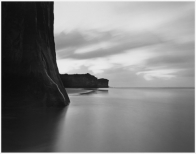Works by Chip Hooper
August 2, 2007
Chip Hooper’s photographs remind us that we don’t need color to make us feel transported to a place. The viewer can sense how the surf sounded a bit distant and the water had the look of a slightly shifting mirror on an afternoon along the Tasman Sea.
Hooper, who lives in the Northern California town of Carmel Valley, spent some time in New Zealand for three years running, beginning in 2003, taking the black-and-white pictures in his exhibition at the Joseph Bellows Gallery. It’s descriptive title: “New Zealand’s South Pacific and Tasman Sea.”
Some of these photographs consist only of sky and sea. Others include flat beach. The human presence is nil, except for the implied presence of the photographer.
“Surf, Tasman Sea” (2005) is palely beautiful. The foreground consists of a thin sheet of water along the shoreline, while a little further out the sea is white with foam. Looking toward the horizon, the line is subtle between lowlying clouds and the water. We can almost read the picture as a feathery abstraction.
Hooper is convincing when the light is dimmer, too. The water is virtually like glass in “Cape Foulwind Beach, Tasman Sea” (2003); the bluffs, far darker than the water, plunge sharply into the sea. The mood is thick. It’s as if you can sense the evocative silence of the place.
It’s fitting that Hooper lives in the Carmel area, strongly associated with the likes of Ansel Adams and Edward Weston. Though distinct from each other, together they defined a West Coast approach to landscape that is a foundation for Hooper’s art. His work is tradition-minded, but not derivative. He has learned from their work, as well as more recent figures like Hiroshi Sugimoto, while giving landscapes his own sort of grandeur.
The New Zealand pictures are related to his earlier “California’s Pacific” series, but look more exotic, perhaps because the places they depict haven’t been seen as often in photographs. One wonderful example veers toward the surreal: it envisions the strange land rock formation called “Giant’s Tooth, Tasman Sea” (2003).
All of Hooper’s selections make up a strong argument for the remarkable difference between photographic prints and reproductions. He takes full advantage of what a large-format view camera has to offer and the detail in the rocks of “Okarito Beach, Tasman Sea” (2003) is like that of an exquisitely worked abstract painting.
